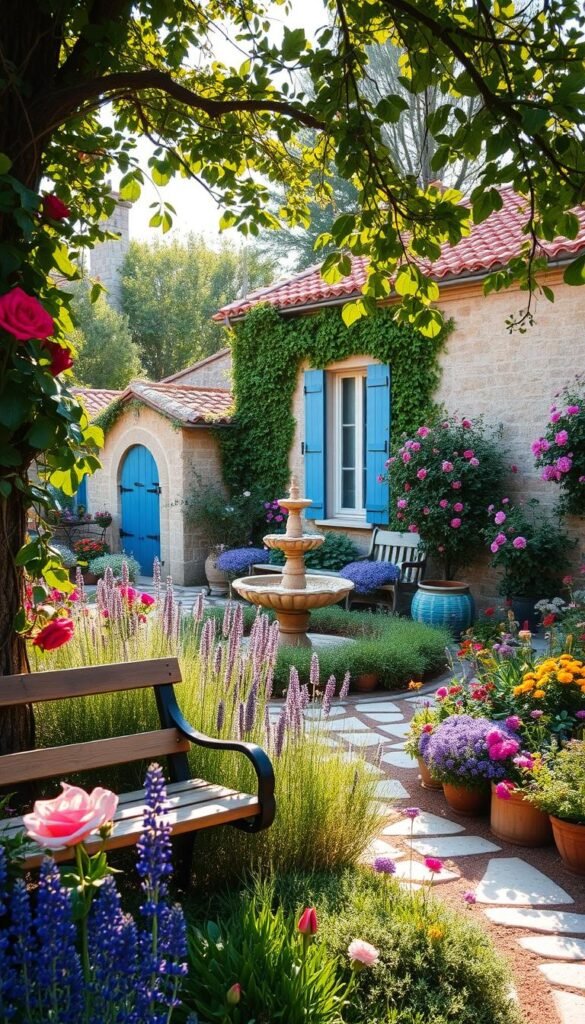Imagine stepping into an outdoor space where wildflowers mingle with structured pathways, and every corner whispers stories of timeless beauty. This is the essence of a countryside-inspired landscape that balances free-spirited growth with intentional design. Whether you have sprawling acres or a cozy backyard, these principles can transform your plot into a sensory retreat.
At its core, this style celebrates contrasts. Geometric hedges frame billowing lavender, while weathered stone benches sit beside vibrant blooms. The magic lies in blending order with spontaneity—a dance between human creativity and nature’s whims. You’ll learn how layered textures, fragrant herbs, and meandering walkways create depth and intrigue.
Water features add soothing sounds, while climbing roses soften walls and fences. Think of your garden as a series of “outdoor rooms”—each with its own mood and purpose. A shaded seating area here, a sunlit herb spiral there. These spaces invite lingering, encouraging you to savor moments outdoors just as you would indoors.
Best of all, this approach adapts to any climate or layout. Start small with potted geraniums and aromatic thyme. Add vintage-inspired accents like wrought-iron gates or terracotta pots for that lived-in charm. Before long, your landscape will feel like a personal escape—one that ages gracefully and delights all five senses.
Embracing the French Cottage Garden Aesthetic
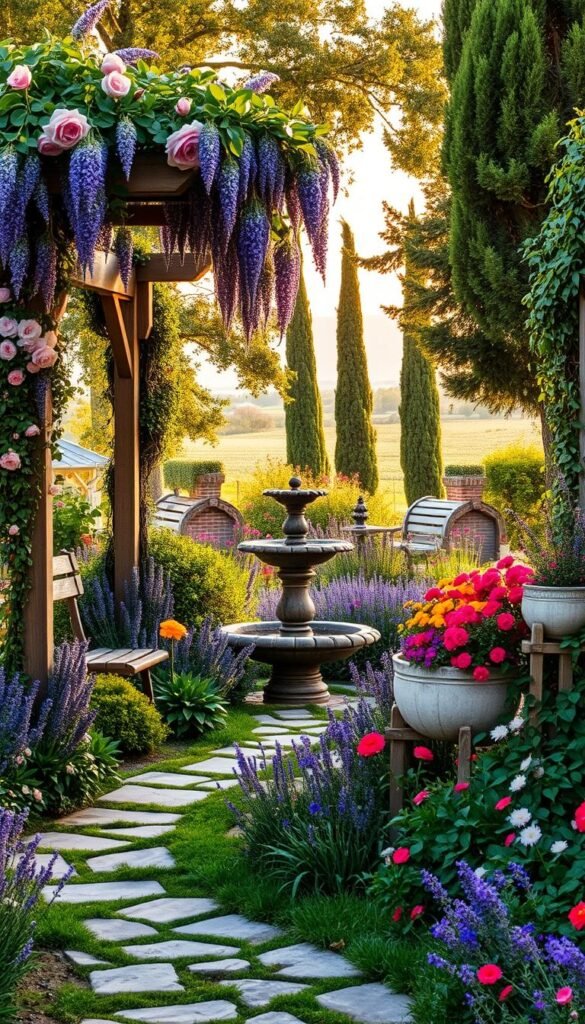
What makes these spaces so captivating is their dance between polish and pastoral ease. Unlike rigid formal layouts, they celebrate imperfections—think uneven cobblestones supporting climbing roses or terracotta pots with chipped edges housing fragrant herbs. This design style thrives on juxtaposition, where refined details meet nature’s raw beauty.
Where Refinement Meets Earthy Character
The secret lies in balancing structure with softness. Weathered limestone paths might curve past billowing lavender, while hand-forged iron gates frame wildflower meadows. These gardens often feature:
- Timeworn materials like aged terracotta or reclaimed wood
- Vertical accents—think jasmine-covered arbors or ivy-draped walls
- A restrained color palette of sage greens, dusky pinks, and sun-bleached whites
Lessons from Sun-Drenched Landscapes
Provençal-inspired spaces prioritize sensory experiences. A single rosemary hedge can perfume the air, while salvaged stone fountains provide soothing water whispers. As one landscape architect notes:
“True elegance comes from letting materials age gracefully—each crack tells a story.”
This approach values intentional simplicity. Instead of filling every corner, strategic placements—a vintage bench under a linden tree or potted bay laurels flanking a doorway—create focal points. The result? A garden that feels curated yet completely organic.
Curating Garden Design Elements: Stone, Iron, and Nature
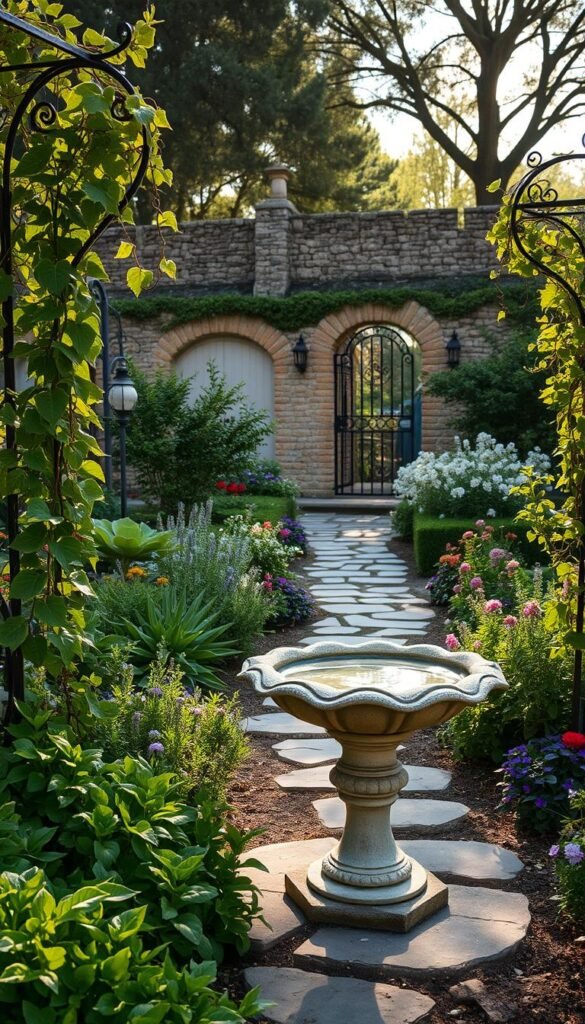
The soul of a timeless outdoor space lies in its materials. By blending rugged textures with delicate foliage, you create visual harmony that feels both intentional and effortless. Let’s explore how to balance these elements for timeless appeal.
Incorporating Antique Planters and Wrought Iron
Start with statement pieces like cast iron Medici urns—their clean lines contrast beautifully with billowing lavender. Authentic wrought iron pieces from Arras often feature hoof-shaped feet or maker’s marks, adding historical depth. For terracotta, seek unglazed Anduze planters. Their green-yellow glazes develop richer patinas over decades.
Balancing Rustic Stone with Greenery
Pair weathered limestone benches with creeping thyme or moss. Use these tips:
- Place heavy stone elements near pathways as permanent anchors
- Softenedges with trailing ivy or rosemary spills
- Speed up patina development by brushing planters with yogurt-moss mixtures
Remember: stone shouldn’t dominate. Let it frame your plantings like a natural sculpture. A reclaimed trough filled with sage becomes a focal point, while iron trellises support climbing roses without overwhelming the scene. This balance creates spaces that feel lived-in yet polished.
Establishing Inviting Outdoor Spaces with French Elegance
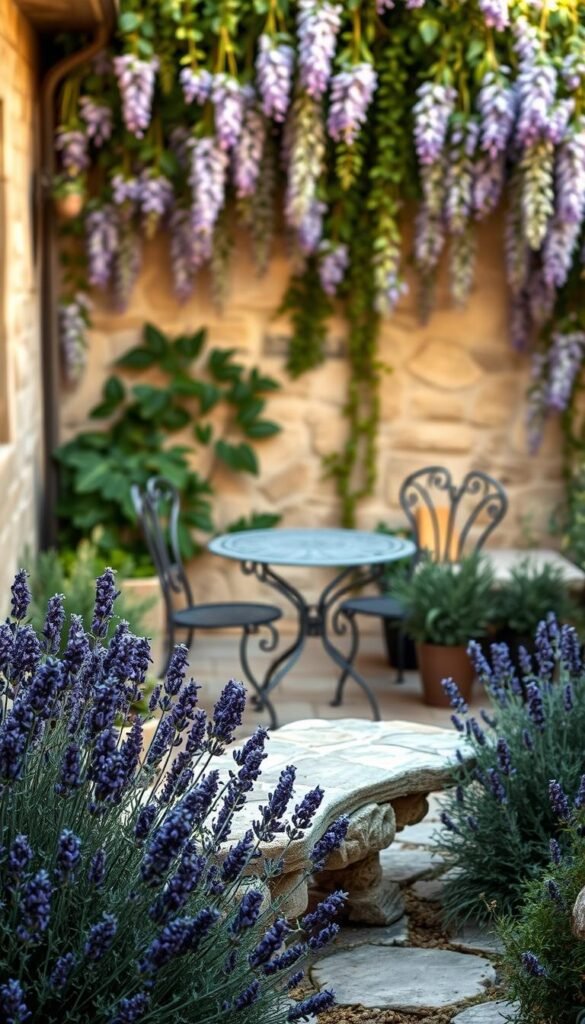
Transform your outdoor space into a living sanctuary where moments unfold naturally. These spaces become extensions of your home, blending comfort with understated charm. The key lies in crafting zones that invite you to slow down and savor simple pleasures.
Designing Comfortable Seating Areas
Start by positioning seating to embrace nature’s rhythms. A bench beneath a maple tree catches morning light, while a wrought-iron bistro set tucked under an awning offers midday shade. Consider these tips:
- Use weathered teak or powder-coated aluminum chairs that age gracefully
- Layer cushions in sun-faded linens for casual elegance
- Frame conversation nooks with low hedges or climbing hydrangeas
Create microclimates by pairing pergolas with drought-tolerant vines. The dappled shade of wisteria cools stone patios, while nearby fountains mask urban noise. As one designer notes:
“Great seating areas feel discovered, not staged—like they’ve always belonged there.”
Mix vintage-modern elements for depth—a concrete fire bowl beside antique planters. Add texture with braided jute rugs underfoot and lavender bordering walkways. These touches build an atmosphere that turns your garden into a personal retreat.
Incorporating Traditional French Elements in Garden Furnishings
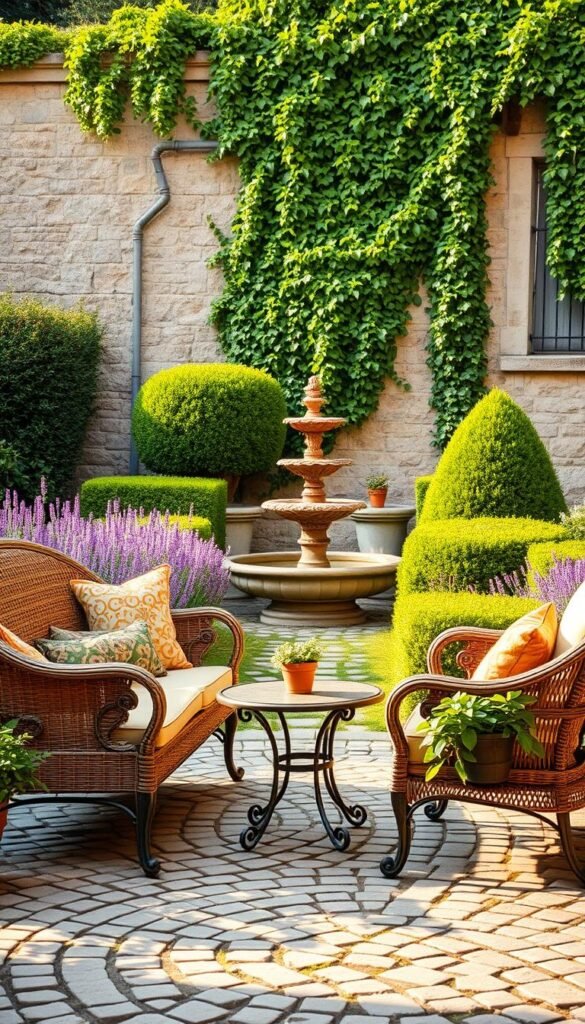
Selecting the right furnishings transforms your outdoor area into a storybook setting. Authentic pieces blend artistry with practicality, creating spaces that feel both curated and effortless. Let’s explore how to choose items that whisper history while standing up to modern use.
Selecting Iron and Marble Furniture
Look for wrought iron pieces with hoof-shaped feet or maker’s badges—hallmarks of genuine Arras craftsmanship. These details add historical depth while ensuring durability. Pair them with marble-topped tables that anchor seating areas without feeling bulky. As one designer notes:
“The best outdoor furniture ages like wine—each scratch and moss patch adds character.”
Consider these popular materials and their benefits:
| Material | Key Features | Maintenance |
|---|---|---|
| Wrought Iron | Wind-resistant, ornate details | Annual rust treatment |
| Carrara Marble | Cool surface, stable base | Seal yearly |
| Faux Bois Cement | Moss-friendly texture | None needed |
Place heavier chairs and tables under trees or on stone patios where they’ll stay year-round. Lighter bistro sets work near herb gardens for casual meals. Mix iron benches with cement stools to create that “collected over decades” charm. Let ivy climb chair legs or let moss soften faux bois surfaces—nature’s touch enhances their timeless appeal.
Crafting a Timeless Ambiance with Water Features and Lighting
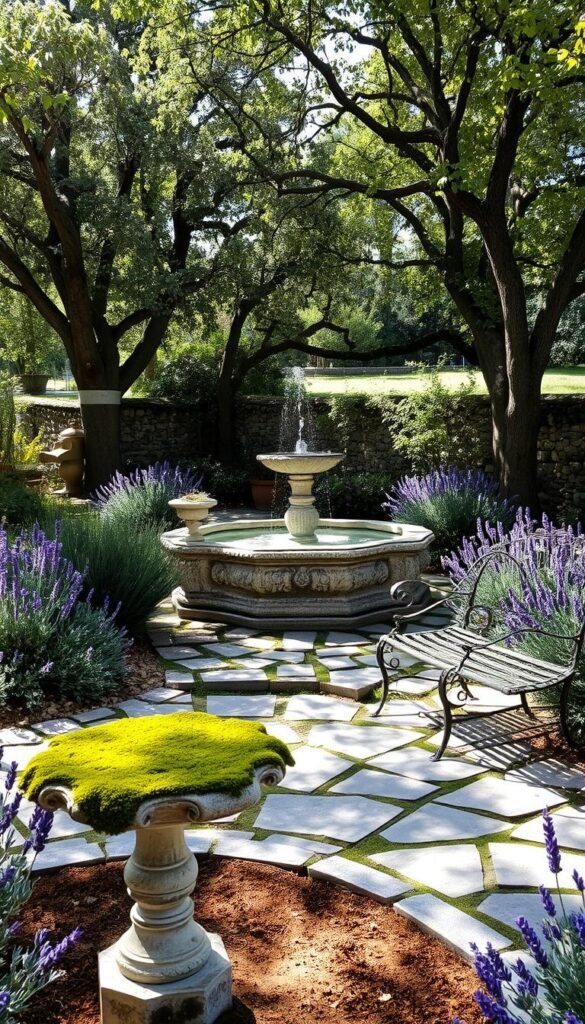
Water whispers and golden-hour glows turn ordinary spaces into sensory escapes. Strategic placement of water features and lighting creates an atmosphere that feels both serene and sophisticated. These elements work together to extend your enjoyment from sunrise strolls to moonlit moments.
Choosing Classic Fountains and Basins
Natural stone basins with aged brass spouts add instant elegance. Opt for self-contained recirculating designs for easy installation. A three-tiered fountain suits larger areas, while reclaimed troughs work in compact corners. Landscape designer Marc Reynaud advises:
“Let water features mirror local geology—limestone in dry regions, mossy granite where rains fall soft.”
Consider maintenance needs:
- Use submersible pumps rated for outdoor use
- Install removable screens to catch debris
- Winterize systems before first frost
Enhancing the Garden with Warm Lighting
Goose-neck sconces cast pools of light on pathways without blinding glare. For timeless appeal, mix lighting types:
| Fixture | Purpose | Placement |
|---|---|---|
| Lanterns | Ambient glow | Entryways |
| Bollard lights | Path marking | Walkway edges |
| String lights | Festive accents | Over seating areas |
LED candles in weathered holders create flickering drama near water elements. Always prioritize dimmable options—you’ll appreciate adjusting brightness for intimate dinners or lively gatherings.
French Cottage Garden Basics: Infuse a Touch of Provence into Your Landscape
Crafting an enchanting outdoor retreat begins with understanding the interplay between human intention and nature’s artistry. This style thrives on contrasts—structured pathways guide your steps, while loose clusters of herbs spill onto walkways. The goal? To create spaces that feel both deliberate and delightfully wild.
Start by blending formal and natural elements. A clipped boxwood hedge might frame a meadow-like planting of poppies and sage. This balance creates visual tension that keeps the eye moving. Use these pairings:
| Element | Purpose | Example Plants |
|---|---|---|
| Structural | Defines space | Boxwood, yew topiaries |
| Softening | Adds movement | Lavender, catmint, roses |
| Transitional | Connects areas | Thyme lawns, gravel paths |
Materials matter deeply. Weathered limestone patios develop character over time, while wrought iron gates gain rust patinas that whisper history. Choose items that age gracefully—rough-hewn benches over plastic replicas. As landscape designer Claire Duvall notes:
“Authenticity isn’t about perfection. It’s about letting materials tell their own story through sun, rain, and time.”
Adapt these concepts to your climate. Swap lavender for Russian sage in colder zones. Use raised beds if drainage challenges arise. Focus on textural contrast—silvery foliage against dark evergreens, or feathery grasses beside glossy holly leaves.
Engage all senses with plants that rustle, scent, and shimmer. Plant jasmine near seating areas for evening fragrance. Include lamb’s ear for tactile interest. This approach transforms your space into a living tapestry that evolves with the seasons.
Planting the Perfect French Garden: Roses, Lavender, and More
The heart of a timeless outdoor space beats in its plant selections. Choosing species that thrive in your climate while evoking pastoral charm creates spaces that feel both intentional and wild. Let’s explore how to layer textures, colors, and scents for year-round delight.
Integrating Iconic Herbs & Flowers
Start with aromatic staples like lavender and rosemary—their silvery foliage pairs beautifully with stone pathways. For kitchen access, cluster thyme and tarragon near seating areas. Pro tip: Plant in odd-numbered groups (3, 5, 7) for natural rhythm.
Consider these pairings for sensory impact:
- Purple sage with white-blooming jasmine
- Variegated mint beside crimson poppies
- Feathery dill towering over creeping thyme
“Fragrance should guide visitors through your space—stronger scents near walkways, subtle ones in quiet corners.”
Arranging Heirloom Roses for Lasting Beauty
Pierre de Ronsard roses thrive in well-drained soil with six hours of sun. Space them 3-4 feet apart for air circulation. Train climbers like New Dawn on iron arbors using soft twine—avoid tight ties that damage stems.
Create depth by layering rose varieties:
| Type | Height | Bloom Period |
|---|---|---|
| Cécile Brunner | 4-6 ft | Spring-Fall |
| Buff Beauty | 5-7 ft | Summer |
| Jacques Cartier | 3-4 ft | Repeat bloomer |
For colder zones, try rugosa roses—their crinkled leaves withstand frost. Always pair with strategic plant placement to highlight their best features.
Creating Pockets of Intimacy with Rustic Accents and Sculptural Details
Your outdoor retreat becomes truly inviting when every corner feels thoughtfully composed yet effortlessly organic. Small touches transform functional areas into moments of discovery, blending practical details with poetic sensibility.
Accenting Spaces with Antique Decor
Weathered copper watering cans make perfect vintage planters for trailing lobelia. Their mottled patinas add instant history to garden corners. Zinc buckets repurposed as herb containers bring rustic charm while serving a purpose.
Place these antique treasures where they’ll catch sunlight—on stone ledges or beside wrought-iron benches. Let moss grow around their bases to enhance the lived-in atmosphere. A chipped terra-cotta statue peeking through lavender creates visual intrigue without feeling staged.
For sculptural impact, try iron scrollwork panels leaning against walls. They frame climbing roses while adding artistic details. These subtle accents build layers of beauty that evolve with time, ensuring your spaces feel both curated and authentically wild.

